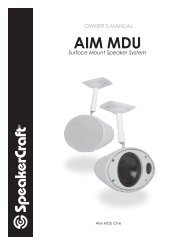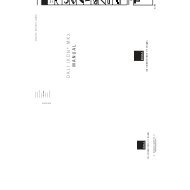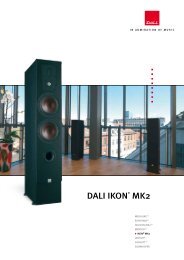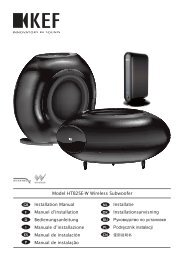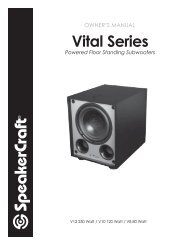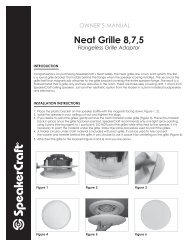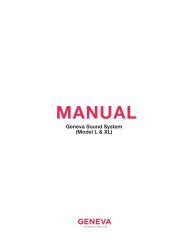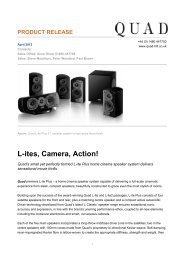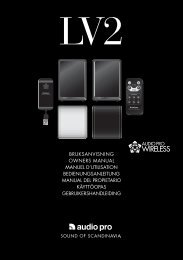Aim Cinema Dipole Five Manual - SpeakerCraft
Aim Cinema Dipole Five Manual - SpeakerCraft
Aim Cinema Dipole Five Manual - SpeakerCraft
You also want an ePaper? Increase the reach of your titles
YUMPU automatically turns print PDFs into web optimized ePapers that Google loves.
Figure 2 Figure 3<br />
INSTALLATION PREPARATION<br />
FINISHED WALL<br />
When installing the AIM DIPOLE into a finished wall, please follow these instructions carefully:<br />
1. Determine Placement<br />
Determine where in the wall the speakers will be placed, using the recommendations under “PLACEMENT”. Pay careful attention<br />
to the section on avoiding obstructions.<br />
2. Locate Obstructions<br />
Find the studs nearest the desired speaker mounting location. The use of a good stud-finder tool is highly recommended for<br />
this procedure. The speakers should be centered between the two 16" on center studs. Make sure that there are no studs or<br />
obstructions where you plan to install the speaker. Read “Check for Obstructions” under the section “PLACEMENT”.<br />
3. Trace Template<br />
Place the cutout template at the location you have decided to place the speaker. Keep in mind that the flange of the speaker<br />
baffle will extend beyond the cut opening by 7 ⁄8" in most cases. Center the template between the studs. With the template<br />
in place, use a level along the top or bottom edge to make sure it is even with the floor and ceiling. Use a few pieces of tape<br />
or small tacks to hold the template in place. See Figure 4. Trace an outline on the wall with a pencil.<br />
Figure 4 Figure 5<br />
TOP VIEW OF WALL<br />
First Cut<br />
Second Cut<br />
4. Cut the Hole<br />
CAUTION: This is the most important part of the entire installation. If you are not certain whether or not an obstruction exist behind<br />
the desired mounting area, you should start by cutting a small hole in the center of your penciled mounting hole with a drywall<br />
saw. Cut at a 45˚ angle towards the inside of the hole. See Figure 5. Cutting the small hole at this angle will make drywall repair<br />
much easier as the piece cut out can be installed neatly back into the hole. Once you have determined that there aren’t any<br />
obstructions in your desired mounting location, start cutting the finished hole at a 90˚ angle to the wall surface.<br />
2



